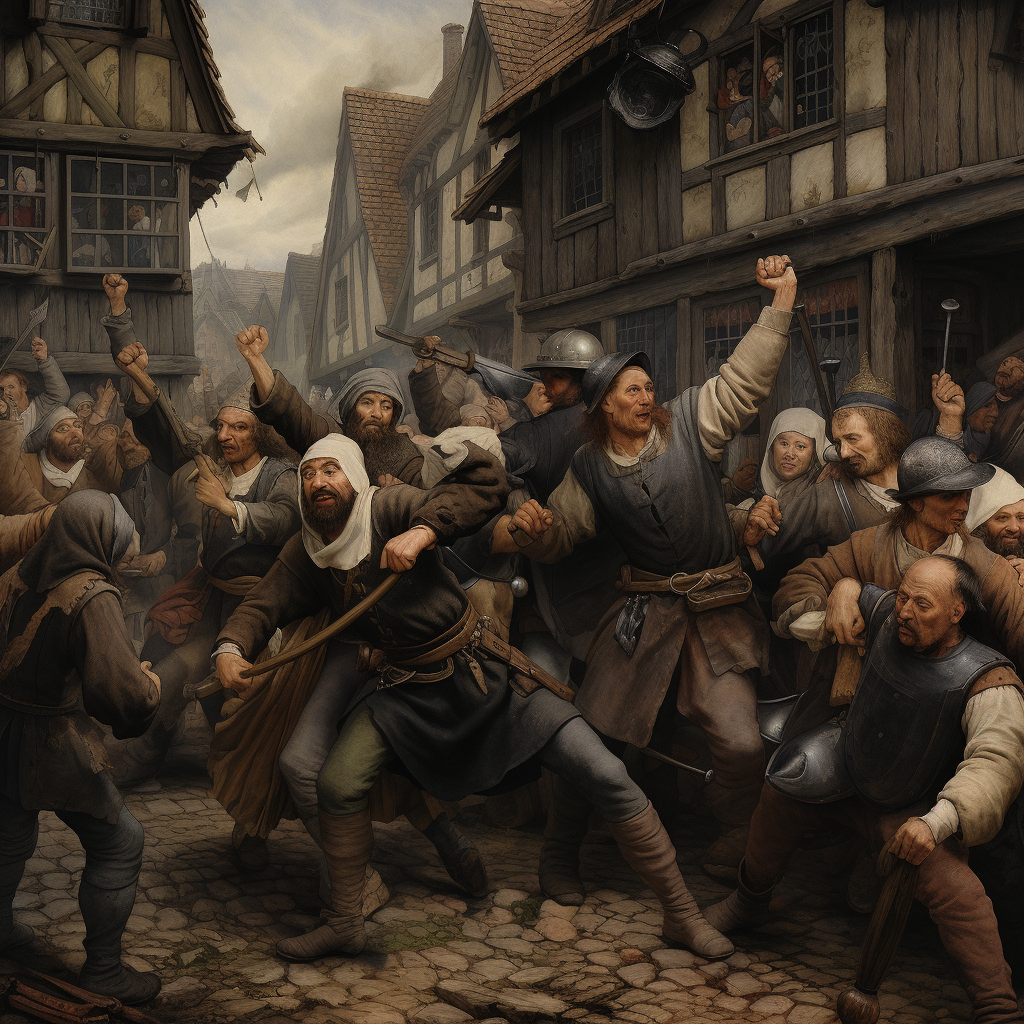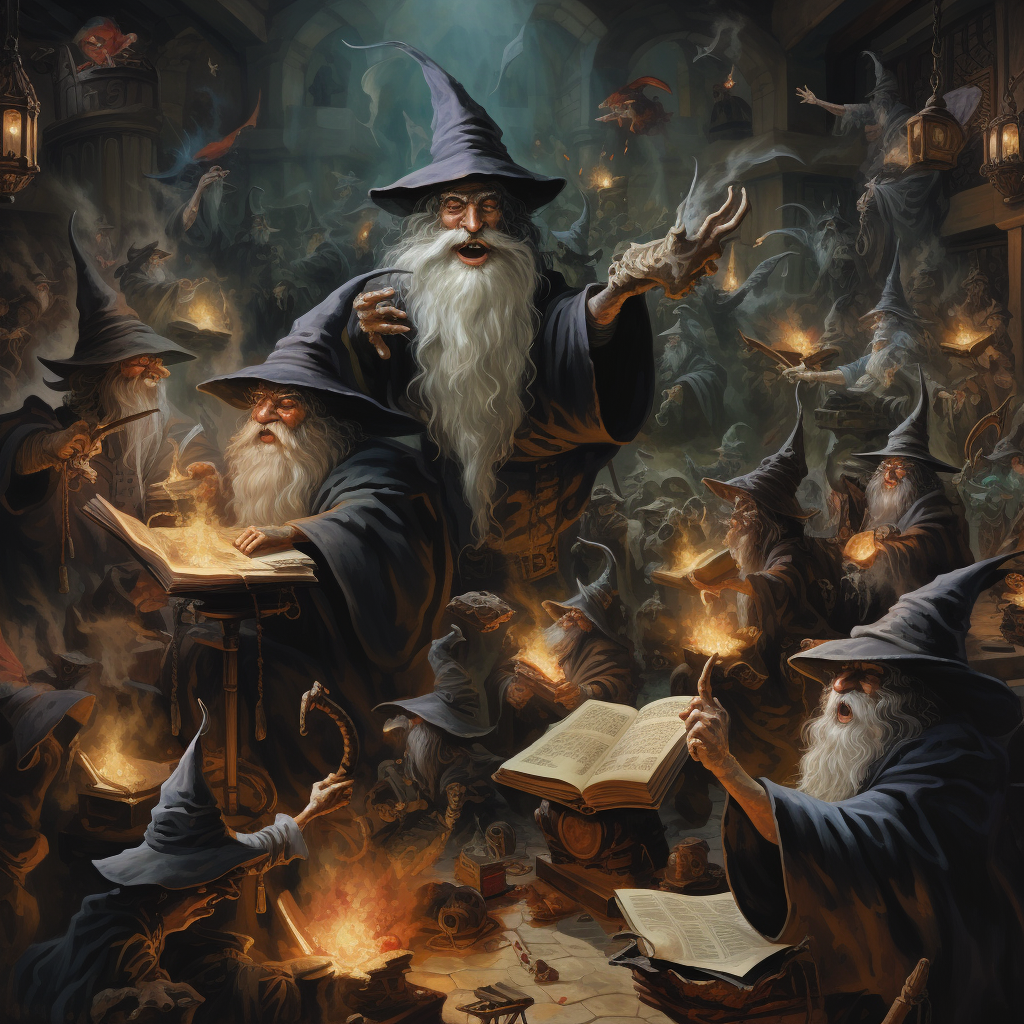Dungeon Master Dispatch
The Dungeon Master's Decalogue:
10 Commandments for Mastering D&D

Welcome, intrepid Dungeon Masters, to the grand tapestry of storytelling and adventure that is Dungeons & Dragons (D&D). Whether you're about to embark on your first campaign or looking to refine your skills, mastering the art of DMing is a journey unto itself. Drawing from the collective wisdom of seasoned DMs across the realm, here are the ten most crucial insights to guide you on your path.

1. Know Your World
Every great story needs a setting, and as a DM, understanding the world in which your adventures unfold is paramount. Whether it's a published setting like the Forgotten Realms or a world of your own creation, immerse yourself in its lore, politics, and geography. This knowledge will enrich your storytelling and provide a solid foundation for your campaigns.
Creating a world from scratch can be a daunting task, but it also offers unparalleled freedom to shape the setting to your vision. Start with the broad strokes: the history that has shaped the world, the major powers that vie for control, and the geography that defines the landscape. From there, you can delve into the details that bring the world to life: the cultures that inhabit it, the conflicts that drive its stories, and the mysteries that await discovery.
Keep in mind that, beyond the town, city, or wilderness grid the party is located at, you will only need to know the most basic information that any inhabitant would know. If you live in America, how much do you really know about Europe? If you live in Europe, how much do you really know about America? It’s less than you think. Even in a city setting, beyond knowing the major sections and what they contain, until your Party, or members of the Party are ready to go there, you don’t need to flesh out all the gritty details.
Even if you choose to set your campaign in a pre-existing world, there's still much to make your own. Each village, city, and wilderness area presents an opportunity to add your personal touch. Familiarize yourself with the setting's history and cultures, but don't be afraid to diverge from canon to serve your story. The most important aspect of your world is that it captivates your players and inspires their adventures.

2. Master the Rules (But Don't Be Enslaved by Them)
A firm grasp of D&D's rules provides the framework for fair and engaging gameplay. However, the best DMs know when to adhere to the letter of the law and when to let the spirit of the game guide them. Flexibility is key; don't let the rules stifle the creativity or momentum of your campaign.
Understanding the rules is crucial, not just for fairness, but for the flow of the game. A DM who knows how combat, spellcasting, and skill checks work can keep the game moving smoothly, avoiding lengthy pauses to look up rules. This fluency allows you to make quick decisions that keep the focus on the adventure, not the rulebook.
Pro Tip:
No one memorizes the entire DM Guide. Use cheat sheets and notes on rules or areas of play that you’re not confident with.
Yet, the rules are not the game's goal; they are its tools. The heart of D&D lies in the stories you tell and the experiences you share. When a rule interferes with the narrative's pace or the players' enjoyment, consider bending it. The goal is to create a memorable and fun experience. If bending a rule enhances the story or the fun, then it's a change worth making.

3. Prepare, Prepare, Prepare
Preparation can make or break a session. Develop plots, craft encounters, and anticipate your players' possible actions. Yet, be ready to improvise—players will always surprise you. A well-prepared DM can adapt on the fly, turning unexpected events into memorable moments.
Preparation goes beyond plotting the story. It involves creating a world that feels alive, with NPCs that have their own goals and personalities, and environments that challenge and intrigue the players. It means having a contingency plan for when players take an unexpected path or when they bypass an encounter you've spent hours designing. The more you prepare, the more seamlessly you can adapt to the unpredictable nature of player choice.
However, preparation is not about scripting every possible outcome; it's about being ready to build the story collaboratively with your players. It's about knowing your world and your story well enough that you can let the players' actions drive the narrative forward in unexpected ways. The magic of D&D lies in the shared storytelling experience, and a prepared DM is the linchpin that holds that experience together.

4. Foster Collaboration
D&D is a collaborative storytelling experience. Encourage your players to contribute to the narrative, making their choices and backgrounds integral to the campaign's development. This shared storytelling creates a richer, more immersive experience for everyone involved.
Collaboration starts with character creation. Work with your players to integrate their characters' backgrounds into the world you've created. This not only gives players a personal stake in the story but also provides you with additional plot hooks to weave into the campaign. When players see their backstories come to life, it deepens their investment in the game.
During the game, encourage players to describe their actions and decisions, not just in terms of mechanics but in terms of storytelling. Ask them how their characters feel about the events unfolding, what their motivations are, and how they interact with the world and each other. This collaborative approach to storytelling enriches the narrative and makes the game more engaging for everyone at the table.
Let the players go where they will. They are going to anyway. As DM, your responsibility is to know what the players characters encounter, no matter which way they go. You may have no idea because you never expected the Party to go into the back room of that tavern, but you have to be able and willing to let them go into that back room, and simply describe an empty room, if you have to. Your job is not to tell the story, that’s the player’s job. Your job is to give the players what they need to tell their story.

5. Balance Is Key
Strive for balance in gameplay, ensuring a mix of combat, exploration, and role-playing. This balance keeps sessions dynamic and engaging for all types of players, catering to a wide range of playstyles and preferences.
Combat is a thrilling part of D&D, but it's not the only part. Balancing combat with exploration and role-playing (social encounters) allows for a richer gaming experience. Exploration lets players discover the world you've created, uncovering its secrets and wonders. Role-playing, on the other hand, allows for character development and deepens the narrative's emotional impact.
Finding the right balance can be challenging, as different players have different preferences. Some may relish combat, while others prefer dialogue and character interaction. Pay attention to your players' reactions and adjust the balance accordingly. The goal is to ensure that each player has moments to shine and feels engaged in every session.

6. Create Memorable NPCs
Non-Player Characters (NPCs) bring your world to life. There are two main types of NPCs, those who are important to furthering the Quest, and the extras.
Extras only need the minimum of detail. The NPCs who further the Quest need to be fleshed out. Invest in their creation, giving them distinct personalities, motivations, and flaws. Memorable NPCs can become beloved allies, dreaded enemies, or complex characters that enrich the narrative.
NPCs are more than just quest givers or combatants; they are the soul of your world. They have their own lives, dreams, and struggles. By creating NPCs with depth, you make the world more immersive and engaging. Players will care about these characters, making their interactions with them more meaningful.
Give your NPCs goals that may align or conflict with the players' objectives. This creates dynamic relationships that can evolve over the course of the campaign. An NPC who starts as an adversary might become an ally, or vice versa. These evolving relationships add depth to the narrative and provide opportunities for complex role-playing interactions.

7. Embrace Failure
Not every roll can be a natural 20, and not every plan goes off without a hitch. Teach your players that failure is part of the game and can lead to some of the most entertaining and unexpected outcomes. Use setbacks as opportunities for growth and storytelling.
Failure is not the opposite of success in D&D; it's an integral part of the adventure. Just as in real life, failure is not just an option, it’s a requirement. It can lead to unexpected twists, force players to think creatively, and provide character development opportunities. When players fail, it's an opportunity to explore the consequences of those failures, which can lead to compelling storytelling.
Encourage your players to embrace failure as part of their characters' journeys. A failed roll can lead to humorous situations, tense moments, or the discovery of new paths. As a DM, how you handle failure can set the tone for the game. Presenting failure as a narrative opportunity rather than a setback fosters a more resilient and creative gaming group.

8. Communicate Clearly and Often
Open lines of communication with your players are vital. Discuss expectations, campaign themes, and boundaries to ensure everyone is on the same page. Regular feedback sessions can help you adjust to your players' preferences and address any concerns.
Before the campaign begins, have a session zero to discuss the type of game everyone is interested in playing. This is the time to talk about the campaign's tone, setting, and the level of role-playing expected. It's also crucial to establish boundaries and discuss any topics that should be avoided to ensure that the game is enjoyable and comfortable for everyone.
Feedback is a two-way street. Encourage your players to share their thoughts on what they're enjoying and what they'd like to see more (or less) of. Talk to your players between Game Sessions! This feedback allows you to tailor the campaign to your players' preferences, ensuring that each session is engaging and fun. Remember, the goal of D&D is for everyone, including the DM, to have a good time.

9. Cultivate Atmosphere
Use music, props, and descriptive language to create an immersive atmosphere. The right ambiance can significantly enhance the gaming experience, making sessions more memorable and engaging.
Music and sound effects can set the mood for different scenes, from the tension of a dungeon crawl to the tranquility of a peaceful village. Props, such as maps and miniatures, help players visualize the world and their place in it. Even simple items like themed decorations or dimmed lighting can contribute to the atmosphere.
Descriptive language is one of the most powerful tools at your disposal. Vivid descriptions can transport players to your world, making them feel the heat of a desert sun or the chill of a haunted crypt. Use all five senses to describe environments and situations, making the world come alive in the players' imaginations.

10. Enjoy the Journey
Lastly, remember that DMing is a labor of love. Enjoy the process of crafting stories, challenging your players, and seeing your world come to life. Your enthusiasm is contagious and will contribute significantly to the enjoyment of your players.
DMing can be challenging, but it's also incredibly rewarding. There's nothing quite like the satisfaction of watching your players engage with the world you've created, overcome challenges, and tell their stories. Embrace the unexpected twists and turns that arise; they're what make D&D such a dynamic and exciting game.
Take time to reflect on your experiences as a DM. Celebrate your successes and learn from any mistakes. Each session is an opportunity to grow and improve. Share your stories with the community; other DMs can be a great source of inspiration and support. Remember, the journey of a Dungeon Master is not just about guiding your players through their adventures but about embarking on your own adventure of creativity, learning, and fun.
Embarking on the journey of a Dungeon Master is both a privilege and a challenge. By adhering to these ten commandments, drawn from the collective wisdom of the D&D community, you'll be well on your way to creating unforgettable adventures that your players will cherish. Remember, the essence of D&D lies in the shared joy and creativity between the DM and the players. Embrace it, and let the dice fall where they may!
Dungeon Master Dispatch
